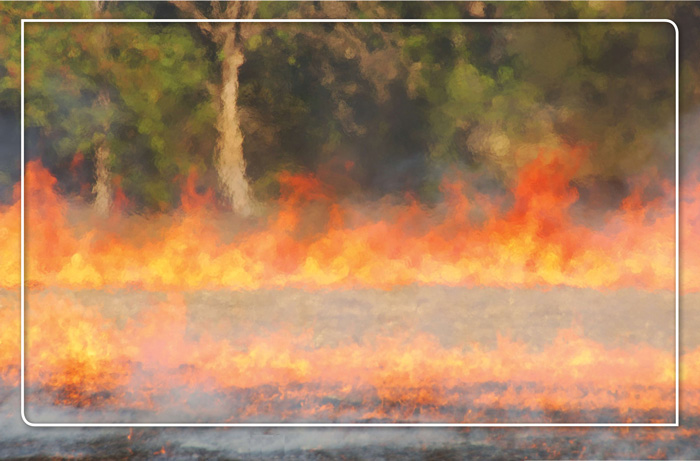November 2018
How ready are you for that dreaded moment when you realise the veldfire is out of control and has taken on a life of its own? How well prepared are your family members and farm workers? How well equipped are your neighbours? Who must be notified and where does one turn for help? It is time to start asking these important questions!
Recent headlines in our newspapers read: Pilanesberg Nature Reserve fire ‘ignited by a neighbour’. A smallholder had decided to burn some rubbish. The wind carried the fire into the reserve where it has damaged almost 8 000 ha. Statistics show that most veld fires are a result of human actions; whether from a tossed cigarette butt (often thrown out of moving cars), burning of vegetation or rubbish or cooking and heating fires lit carelessly.
Veld fires don’t respect boundaries and are a serious problem. They threaten lives, present a risk to property, contribute to reduced soil fertility and destroy vegetation. They can become runaway emergencies that become disasters. Fire is an important ‘tool’ for humankind used for many different reasons including heating, cooking and managing farm lands and grazing lands. Fires also occur naturally and can be started by lightning strikes.
Do you know that you may not stand by and watch a wildfire spread across your land? You have a legal responsibility to report the fire to authorities and neighbours and you have to help contain it. This is why we have to be prepared to manage planned and unplanned fires and veldfires respectfully and considerately by having a fire fighting strategy in place.
Who must prepare?
Everyone who owns, or rents land has a responsibility to control the fires on his or her land. The National Veld and Forest Fire Act states that every owner on whose land a veld fire may start or burn and from whose land it may spread must be prepared and be in a state of readiness.
Readiness for fire fighting
This requires the responsible person to have the necessary equipment, protective clothing and training for extinguishing fires. This readiness is expected to be in proportion to the risk that the owner must manage so if you have 1 ha of land, you cannot be expected to have a huge firefighter standing at the ready on a tractor – but you can be expected to lend a hand with a knapsack sprayer filled with water or a fire-beater.
It is also reasonable to expect you and your farm workers to assist to control the fire on your property and to stop it from spreading beyond your boundaries. In the case of an absentee owner, the Act requires that every landowner or tenant must have a responsible person available to help extinguish a fire and to take steps to alert the neighbours and nearest officials.
Firebreaks
It is true that firebreaks are probably not going to stop the path of every fire. There are times when the wind picks up and blows a fire straight across a break. However, firebreaks do stop many fires and they provide a safer space for firefighters to work along when fighting fires or burning back with counter-fires.
It is important for landowners to work with their broader community and their neighbours. It is a landowner’s responsibility to be in communication with other farmers as to when the fire break season is held and when everyone should burn. The day set for burning must be mutually acceptable.
Neighbours should work together in burning breaks along shared boundaries. They must be sure to have adequate assistance. It is essential that the fire is carefully managed and contained. Leadership on the day is essential. That person must decide whether conditions are ideal. If a wind has sprung up, then the burn must be halted and postponed to a quiet windless day.
A landowner may not burn wherever he or she pleases. Attention must be paid to the weather, the terrain and the vegetation when deciding how to prepare the fire break. The break must be made so that it is wide enough and long enough to have a reasonable chance of stopping a veldfire. It must not cause soil erosion and it must be reasonably free of inflammable material. Many farmers plan their breaks well in advance and spray the designated area with weed control to reduce dry matter and the risk caused by flammable weeds and brush.
Fire Protection Associations
It is important to note that firebreak legislation and practices differ significantly in different parts of the country, so it’s up to every landowner to establish firebreak procedures in their specific region and then comply. Many communities formalise their cooperation by establishing a local Fire Protection Association (FPA). This is a good system as it ensures the community has a veldfire management strategy in place and the FPA rules are enforceable.
The community can benefit from skills development and other assistance. There is improved communication between members, authorities and other stakeholders.
While some areas are highly legislated, there are other areas where other methods of fire control are deemed adequate i.e. grading, ploughing, and disking are other methods apart from burning. If you are a landowner or lease land, please take time to develop a fire management strategy for yourself and in your community – better safe than sorry!
Further reading is available at: http://www.daff.gov.za.
Article submitted by Jenny Mathews, Pula Imvula contributor. For more information, send an email to jenjonmat@gmail.com.

Publication: November 2018
Section: Pula/Imvula